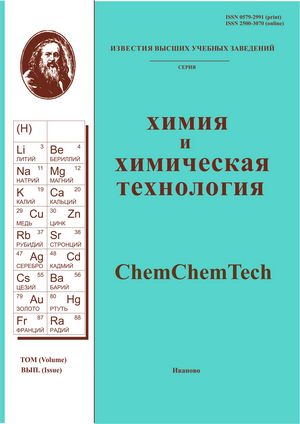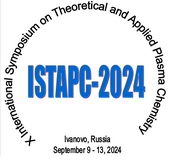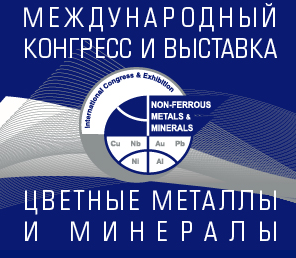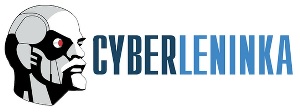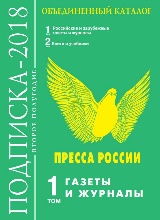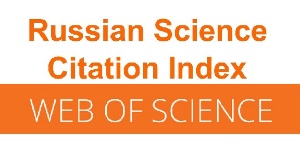СПЕКТРОСКОПИЧЕСКИ И / ИЛИ СТРУКТУРНО ИНТРИГУЮЩИЕ ФТАЛОЦИАНИНЫ И ПОДОБНЫЕ СОЕДИНЕНИЯ. ЧАСТЬ 3. ДИМЕРНЫЕ СИСТЕМЫ, ТЕТРАМЕРЫ И ВЫВОДЫ
Аннотация
Данная работа является третьей частью обзора, в котором представлены свойства большой группы фталоцианинов, которые были синтезированы и спектроскопически и теоретически изучены в работах, выполненных под руководством автора за период 2007-2017 гг. Приведены примеры анализа спектроскопических данных в сочетании с квантово-химическими расчетами различного уровня. В качестве спектроскопических методов использовалсь методы электронного поглощения, естественного и магнитного кругового дихроизма (CD и MCD) флуоресценции, фосфоресценции и электронного парамагнитного резонанса с временным разрешением. На основе квантово-химических расчетов теоретически проанализированы спектры (4n + 2) p систем, а также некоторые 4np антиароматических систем. В отличие от первой и второй частей обзора, в данной части рассматриваются димерные и тетрамерные системы.
<span style="opacity: 0;"> . . . . . . . . . . . . . . . . . . . . . . . . . . . . . . . . . . . . . . . . . . . </span>
<span style="opacity: 0;"> . . . . . . . . . . . . . . . . . . . . . . . . . . . . . . . . . . . . . . . . . . . </span>
<span style="opacity: 0;"> . . . . . . . . . . . . . . . . . . . . . . . . . . . . . . . . . . . . . . . . . . . </span>
Литература
Oniwa K., Shimizu S., Shiina Y., Fukuda T., Kobayashi N. A μ-oxo Hetero Dimer of Silicon Phthalocyanine and Naphthalocyanine. Chem. Commun. 2013. V. 49. P. 8341-8343.
Ciliberto E., Doris K.A., Pietro W.J., Reisner G.M., Ellis D.E., Fragala I., Herbstein F.H., Ratner M.A., Marks T.J. The π-π Interactions and Bandwidths in Molecular Metals. A Chemical, Structural, Photoelectron Spectroscopic, and Hartree-Fock-Slater Study of Monomeric and Cofacially Joined Dimeric Silicon Phthalocyanines. J. Am. Chem. Soc. 1984. V. 106. P. 7748-7761.
(a) Kleinwachter J. PhD thesis. Germany: University of Tubingen. 1994.; (b) Li Z. Y., Lieberman M. Axial Reactivity of Soluble Silicon(IV) Phthalocyanines. Inorg. Chem. 2001. V. 40. P. 932-939.
(a) Ferencz A., Neher D., Schulze M., Wegner G., Viaene L., Deschryver F.C. Synthesis and Spectroscopic Properties of Phthalocyanine Dimers in Solution. Chem. Phys. Lett. 1995. V. 245. P. 23-29; (b) Oddos Marcel L., Madeore F., Bock A., Neher D., Ferencz A., Rengel H., Wagner G., Kryschi C., Trommsdorff H.P. Electronic States and Relaxation Dynamics of Silicon Phthalocyanine Dimers. J. Phys. Chem. 1996. V. 100. P. 11850-11856.
Kleinwachter J., Hanack M. Rotational Isomers in Stacked Macrocycles: Synthesis and Spectroscopic Properties of Peripherally Substituted (μ-Oxo)bis(phthalocyaninatosilicon) Compounds. J. Am. Chem. Soc. 1997. V. 119. P. 10684-10695.
Muranaka A., Matsumoto Y., Uchiyama M., Jiang J., BianY., Ceulemans A., Kobayashi N. Definitive Assignments of the Visible−Near-IR Bands of Porphyrin-Naphthalocyanine Rare-Earth Sandwich Double- and Triple-Decker Compounds by Magnetic Circular Dichroism Spectroscopy. Inorg. Chem. 2005. V. 44. P. 3818-3826.
Gouterman M. In: The Porphyrins. Ed. by D. Dolphin. New York: Academic Press. 1978. V. 3. Chap. 1.
(a) Ishikawa N., Kaizu Y. Disappearance of MCD A Term in the Fingerprint Band of Cation Radicals of Phthalocyanine Metal Complexes. Chem. Phys. Lett. 2001. V. 339. P. 125-132. (b) Ishikawa N., Ohno O., Kaizu Y. Electronic States of Bis(phthalocyaninato)lutetium Radical and Its Related Compounds: The Application of Localized Orbital Basis Set to Open-Shell Phthalocyanine Dimers. J. Phys. Chem. 1993. V. 97. P. 1004-1010.
Ricciardi G., Rosa A., Baerends E.J., van Gisbergen S.A.J. Electronic Structure, Chemical Bond, and Optical Spectra of Metal Bis(porphyrin) Complexes: A DFT/TDDFT Study of the Bis(porphyrin) M(IV) (M=Zr, Ce, Th) Series. J. Am. Chem. Soc. 2002. V. 124. P. 12319-12334.
Jiang J., Bian Y., Furuya F., Liu W., Choi M.T.M., Kobayashi N., Li H.-W., Yang Q., Mak T.C.W., Ng D.K.P. Synthesis, Structure, Spectroscopic Properties, and Electrochemistry of Rare Earth Sandwich Compounds with Mixed 2,3-Naphthalocyaninato and Octaethylporphyrinato Ligands. Chem. Eur. J. 2001. V. 7. P. 5059-5069.
Michl J. Magnetic Circular Dichroism of Cyclic. Pi.-electron Systems. 1. Algebraic Solution of the Perimeter Model for the A and B Terms of High-Symmetry Systems with a (4N+2) π-Electron [n] Annulene Perimeter. J. Am. Chem. Soc. 1978. V. 100. P. 6801-6811.
Michl J. Magnetic Circular Dichroism of Cyclic. Pi.-electron Systems. 2. Algebraic Solution of the Perimeter Model for the B Terms of Systems with a (4N +2) π-Electron [n] Annulene Perimeter. J. Am. Chem. Soc. 1978. V. 100. P. 6812-6818.
Michl J. Electronic structure of aromatic π-electron systems as reflected in their MCD spectra. Pure. Appl. Chem. 1980. V. 52. P. 1549–1563.
Michl J. Magnetic Circular dichroism of Aromatic Molecules. Tetrahedron 1984. V. 40. P. 3845–3934.
Zhang X., Muranaka A., Lv W., Zhang Y., Bian Y., Jiang J., Kobayashi N. Optically Active Mixed Phthalocyaninato–Porphyrinato Rare-Earth Double-Decker Complexes: Synthesis, Spectroscopy, and Solvent-Dependent Molecular Conformations. Chem. Eur. J. 2008. V. 14. P. 4667–4674.
Lu H., Kobayashi N. Optically Active Porphyrin and Phthalocyanine Systems. Chem. Rev. 2016. V. 116. P. 6184-6261.
For example, the electronic absorption data for [YH{Pc(α-OC4H9)8}(TClPP)] in DMF λmax (log ε): 325 (5.05), 418 (5.49), 495 (4.83), 596 (4.50), 654 (4.70), 853 (4.51), 933 nm (4.33); in CHCl3 λmax (log ε): 323 (4.85), 418 (5.40), 498 (4.75), 571 (4.20), 627 (4.56), 880 (sh), 954 nm (4.20); the electronic absorption data for [Y(Pc)(TClPP)] in DMF λmax (log ε): 335 (4.89), 391 (4.74), 412 (5.01), 479 (4.63), 586 (4.28), 637 (4.29), 814 nm (4.14); in CHCl3 λmax (log ε): 332 (4.92), 401 (5.03), 470 (4.70), 732 (3.55), 1034 (3.79), 1238 (3.91), 1656 nm (3.49); the data for [Y(Pc)(TClPP)] in CHCl3 are cited from: Lu F., Sun X., Li R., Liang D., Zhu P., Zhang X., Choi C.-F., Ng D. K. P., Fu-kuda T., Kobayashi N., Jiang J. Synthesis, Spectroscopic Properties, and Electrochemistry of Heteroleptic Rare Earth Double-Decker Complexes with Phthalocyaninato and meso-Tetrakis(4-chlorophenyl)porphyrinato Ligands. New J. Chem. 2004. V. 28. P. 1116-1122.
Ng D.K.P., Jiang J. Sandwich-Type Heteroleptic Phthalocyaninato and Porphyrinato Metal Complexes. Chem. Soc. Rev. 1997. V. 26. P. 433–442.
Mack J., Stillman M.J., Kobayashi N. Application of MCD Spectroscopy to Porphyrinoids. Coord. Chem. Re-view. 2007. V. 251. P. 429-453.
Kobayashi N., Nakai K. Applications of Magnetic Circular Dichroism Spectroscopy to Porphyrins and Phthalocyanines. Chem. Commun. (Feature Article). 2007. P. 4077-4092.
Mack J., Kobayashi N. Low Symmetry Phthalocyanines and Their Analogues. Chem. Rev. 2011. V. 111. P. 281-321.
a) Kobayashi N., Kobayashi Y., Osa T. Optically Active Phthalocyanines and Their Circular Dichroism. J. Am. Chem. Soc. 1993. V. 115. P. 10994–10995; b) Kobayashi N. Optically Active 'Adjacent' Type Non-Centrosymmetrically Substituted Phthalocyanines. Chem. Commun. 1998. P. 487–488; c) Kobayashi N., Higashi R., Titeca B. C., Lamote F., Ceulemans A. Substituent Induced Circular Dichroism in Phthalocyanines. J. Am. Chem. Soc. 1999. V. 121. P. 12018–12028.
Wang R., Li R., Li Y., Zhang X., Zhu P., Lo P.-C., Ng D.K.P., Pan N., Ma C., Kobayashi N., Jiang J. Controlling the Nature of Mixed (Phthalocyaninato)(porphyrinato) Rare-Earth(III) Double-Decker Complexes: The Effects of Nonperipheral Alkoxy Substitution of the Phthalocyanine Ligand. Chem. Eur. J. 2006. V. 12. P. 1475–1485.
Jiang J., Kasuga K., Arnold D.P. Sandwichtype Phthalocyaninato and Porphyrinato Metal Complexes. In: Supramolecular Photosensitive and Electroactive Materials. Ed. by H.S. Nalwa. New York: Academic Press. 2001. Chap. 2. P. 113–210.
Asano Y., Muranaka A., Fukasawa A., Hatano T., Uchiyama M., Kobayashi N. anti-[2.2](1,4)Phthalocyaninophane: Spectroscopic Evidence for Transannular Interaction in the Excited States. J. Am. Chem. Soc. 2007. V. 129. P. 4516-4517.
(a) Scholes G.D., Fleming G.R. On the Mechanism of Light Harvesting in Photosynthetic Purple Bacteria: B800 to B850 Energy Transfer. J. Phys. Chem. B. 2000. V. 104. P. 1854-1868. (b) Jordanides X.J., Scholes G.D., Fleming G.R. The Mechanism of Energy Transfer in the Bacterial Photosynthetic Reaction Center. J. Phys. Chem. B. 2001. P. 105. P. 1652-1669.
Kobayashi N. Dimers, Trimers, and Oligomers of Phthalocyanines and Related Compounds. Coord. Chem. Rev. 2002. V. 227. P. 129-152.
Kobayashi N. Synthesis and Spectroscopic Properties of Phthalocyanine Analogues. In: Handbook of Porphyrins and Related Macrocycles. Ed. by K.M. Kadish, K.M. Smith, R. Guilard. New York: Academic Press. 2002. V. 15. Chap. 100. P. 161-262.
Kameyama K., Morisue M., Satake A., Kobuke Y. Highly Fluorescent Self‐Coordinated Phthalocyanine Dimers. Angew. Chem., Int. Ed. 2005. V. 44. P. 4763-4766.
Kobayashi N., Fukuda T., Lelievre D. Band Deconvolution Analysis of the Absorption and Magnetic Circular Dichroism Spectral Data of a Planar Phthalocyanine Dimer. Inorg. Chem. 2000. V. 39. P. 3632-3637.
Modern Cyclophane Chemistry. Ed. by R. Gleiter, H. Hopf. Weinheim, Germany: VCH. 2004.
Kasha M., Rawls H.R., El-Bayoumi M.A. The Exciton Model in Molecular Spectroscopy. Pure Appl. Chem. 1965. V. 11. P. 371-392.
Liu Q., Shimizu S., Kobayashi N. Cyclophanes Containing Bowl-Shaped Aromatic Chromophores: Three Isomers of anti-[2.2](1,4)Subphthalocyaninophane. Angew. Chem. Int. Ed. 2015. V. 54. P. 5187-5191.
Hope H., Truebloo K.N., Bernstein J. The Crystal and Molecular Structure of 1,1,2,2,9,9,10,10-Octafluoro-[2,2]Paracyclophane and a Reinvestigation of the Structure of [2,2]Paracyclophane. Crystallogr. Sect. B. 1972. V. 28. P. 1733-1743.
Kaito A., Nozawa T., Yamamoto T., Hatano M., Orii Y. LCAO MO SCF π-Electron Calculations on the Magnetic Circular Dichroism of Porphyrin, Protoporphyrin, and Porphyrin a. Chem. Phys. Lett. 1977. V. 52. P. 154-160.
Although the transition energies were slightly overestimated, use of the longrange corrected CAM-B3LYP exchange-correlation functional for the TDDFT calculations reproduced well the splitting of the Q band on going from CC to CV and further to VV: Yanai T., Tew D.P., Handy N.C. A New Hybrid Exchange–Correlation Functional Us-ing the Coulomb-Attenuating Method (CAM-B3LYP). Chem. Phys. Lett. 2004. V. 393. P. 51-57.
Kobayashi N., Lam H., Nevin W.A., Janda P., Leznoff C.C., Koyama T., Monden A., Shirai H. Synthesis, Spec-troscopy, Electrochemistry, Spectroelectrochemistry, Langmuir-Blodgett Film Formation, and Molecular Orbital Calculations of Planar Binuclear Phthalocyanines. J. Am. Chem. Soc. 1994. V. 116. P. 879-890.
Shibata N., Mori S., Hayashi M., Ueda M., Tokunaga E., Shiro M., Sato H., Hoshi T., Kobayashi N. A Phthalocyanine-Subphthalocyanine Heterodinuclear Dimer: Comparison of Spectroscopic Properties with Those of Homodinuclear Dimers of the Constituting Units. Chem. Commun. 2014. V. 50. P. 3040-3043.
Mack J., Liang X., Dubinina T.V., Tomilova J.G., Nyokong T., Kobayashi N. MCD Spectroscopy and TD-DFT Calculations of a Naphthalene-ringbridged Coplanar Binuclear Phthalocyanine Dimer. J. Porph. Phthal. 2013. V. 17. P. 489-500.
Asano Y., Sato J., Furuyama T., Kobayashi N. A Zinc Gable Phthalocyanine and a Derived Planar Bis-Phthalocyanine Containing a Shared Anthracene Unit. Chem. Commun. 2012. V. 48. P. 4365-4367.
Leznoff C.C., Lam H., Marcuccio S.M., Nevin W.A., Janda P., Kobayashi N., Lever A.B.P. A Planar Binuclear Phthalocyanine and Its Dicobalt Derivatives. Chem. Soc., Chem. Commun. 1987. P. 699-701.
All calculations were performed at the DFT level or ZIN-DO/S Hamiltonian, implemented in Gaussian 09. The model structures (tertbutyl groups were omitted, 1’, 2’, and 3’) were used as model structures. Frisch M.J., Trucks G.W., Schlegel H.B., Scuseria G.E., Robb M.A., Cheeseman J.R., Scalmani G., Barone V., Mennucci B., Petersson G.A., Nakatsuji H., Caricato M., Li X., Hratchian H.P., Izmaylov A.F., Bloino J., Zheng G., Sonnenberg J.L., Hada M., Ehara M., Toyota K., Fuku-da R., Hasegawa J., Ishida M., Nakajima T., Honda Y., Kitao O., Nakai H., Vreven T., Montgomery J.A., Jr., Peralta J.E., Ogliaro F., Bearpark M., Heyd J.J., Brothers E., Kudin K.N., Staroverov V.N., Kobayashi R., Normand J., Raghavachari K., Rendell A., Burant J.C., Iyengar S.S., Tomasi J., Cossi M., Rega N., Millam J.M., Klene M., Knox J.E., Cross J.B., Bakken V., Adamo C., Jaramillo J., Gomperts R., Stratmann R.E., Yazyev O., Austin A.J., Cammi R., Pomelli C., Ochterski J.W., Martin R.L., Morokuma K., Zakrzewski V.G., Voth G.A., Salvador P., Dannenberg J.J., Dapprich S., Daniels A.D., Farkas Ö., Foresman J.B., Ortiz J.V., Cioslowski J., Fox D.J. Gaussian 09, Revision E.01. Gaussian, Inc. Wallingford CT. 2009.
Ito S., Nakamoto K., Uno H., Murashima T., Ono N. Synthesis of a Gable Bis-Porphyrin Linked with a Bicyclo[2.2.2]octadiene Ring and Its Conversion into a Conjugated Planar Bis-Porphyrin. Chem. Commun. 2001. P. 2696-2697.
Ishii K., Abiko S., Fujitsuka M., Ito O., Kobayashi N. Exciton Interactions in a Self-Assembled Phthalocycnine Dimer. J. Chem. Soc., Dalton Trans. 2002. P. 1735-1739.
Muranaka A., Asano Y., Tsuda A., Osuka A., Kobayashi N. Spectroscopic and Theoretical Studies of Optically Active Porphyrin Dimers: A System Uninterpretable by Exciton Coupling Theory. Chem. Phys. Chem. 2006. V. 7. P. 1235-1240.
Kobayashi N., Muranaka A., Mack J. Circular Dichroism and Magnetic Circular Dichroism for Organic Chemists (textbook). London: Royal Society of Chemistry. 2012 (comments in Angew. Chem. Int. Ed. 2012. V. 51. P. 10446).
Harada N., Ono H., Uda H., Parveen M., Khan N.U-P., Achari B.P.K. Atropisomerism in Natural Products. Absolute stereochemistry of Biflavone, (-)-4',4''',7,7''-Tetra-O-Methylcupressuflavone, as Determined by the Theoretical Calculation of CD Spectra. J. Am. Chem. Soc. 1992. V. 114. P. 7687–7692.
Furche F., Ahlrichs R., Wachsmann C., Weber E., Sobanski A., Vçgtle F., Grimme S. Circular Dichroism of Helicenes Investigated by Time-Dependent Density Functional Theory. J. Am. Chem. Soc. 2000. V. 122. P. 1717-1724.
Diedrich C., Grimme S. Systematic Investigation of Modern Quantum Chemical Methods to Predict Electronic Circular Dichroism Spectra. J. Phys. Chem. A. 2003. V. 107. P. 2524-2539.
Toyota S., Shimasaki T., Tanifuji N., Wakamatsu K. Experimental and Theoretical Investigations of Absolute Stereochemistry and Chiroptical Properties of Enantiopure 2,2’-Substituted 9,9’-Bianthryls. Tetrahedron: Asymmetry. 2003. V. 14. P. 1623-1629.
Tsuda A., Furuta H., Osuka A. Syntheses, Structural Characterizations, and Optical and Electrochemical Proper-ties of Directly Fused Diporphyrins. J. Am. Chem. Soc. 2001. V. 123. P. 10304-10321.
Muranaka A., Yokoyama M., Matsumoto Y., Uchiyama M., Tsuda A., Osuka A., Kobayashi N. Magnetic Circular Dichroism Study of Directly Fused Porphyrins. Chem. Phys. Chem. 2005. V. 6. P. 171-179.
Fukuda T., Biyajima T., Kobayashi N. A Discrete Quadruple-Decker Phthalocyanine. J. Am. Chem. Soc. 2010. V. 132. P. 6278-6279.
(a) Weiss R., Fischer J. Lanthanide Phthalocyanine Complexes. In: The Porphyrin Handbook. Ed. by K.M. Kadish, K.M. Smith, R. Guilard. San Diego: Academic Press. 2003. V. 16. Chap. 105. pp 171-246. (b) Buchler J.W., Ng D.K.P. Metal Tetrapyrrole Double- and Triple-Deckers with Special Emphasis on Porphyrin Systems. In: The Porphyrin Handbook. Ed. by K.M. Kadish, K.M. Smith, R. Guilard. San Diego: Academic Press. 2003. V. 3. Chap. 20. P. 245-294.
George R.D., Snow A.W., McMillan P.F., Burrows V.A. Synthesis and Characterization of an Oligomeric Mercury-Bridged Phthalocyanine. J. Am. Chem. Soc. 1992. V. 114. P. 8286-8287.
Chambrier I., White G.F., Cook M.J. Oligomeric Cadmium–Phthalocyanine Complexes: Novel Supramolecular Free Radical Structures. Chem. Eur. J. 2007. V. 13. P. 7608-7618.
Kobayashi N. Spectroscopically and/or Structurally Intriguing Phthalocyanines and Related Compounds. Part 1. Monomeric systems. Izv. Vyssh. Uchebn. Zaved. Khim. Khim. Tekhnol. [Russ. J. Chem. & Chem. Tech.]. 2019. V. 62.
N 4. P. 4-46.
Konami H., Hatano M., Tajiri A. An Analysis of Paramagnetic Shifts in Proton MNR Spectra of Non-Radical Lanthanide(III)-Phthalocyanine Sandwich Complexes. Chem. Phys. Lett. 1989. V. 160. P.163-167.
Ishikawa N. Electronic Structures and Spectral Properties of Double- and Triple- Decker Phthalocyanine Complexes in a Localized Molecular Orbital View. J. Porph. Phthal. 2001. V. 5. P. 87-101.
(a) Guyon F., Pondaven A., Kerbaol J.M., L’Her M. From the Single to the Triple-Decker Sandwich. Effect of Stacking on the Redox and UV−Visible Spectroscopic Properties of Lutetium(III) 1,2-Naphthalocyaninate Complexes. Inorg. Chem. 1998. V. 37. P. 569-576. (b) Dewulf D.W., Leland J.K., Wheeler B.L., Bard A.J., Batzel D.A., Dininny D.R., Kenney M.E. Spectral Study of Tris(β-dionato)cobalt(III) Chelates. Structure-Redox Potential Relations. Inorg. Chem. 1987. V. 26. P. 26-32.
Nakamura Y., Aratani N., Shinikubo H., Takagi A., Kawai T., Matsumoto T., Kim D., Muranaka A., Kobayashi N., Osuka A. A Directly Fused Tetrameric Porphyrin Sheet and Its Anomalous Electronic Properties That Arise from the Planar Cyclooctatetraene Core. J. Am. Chem. Soc. 2006. V. 128. P. 4119-4127.
Nakamura Y., Hwang I.-W., Aratani N., Ahn T.K., Ko D.M., Takagi A., Kawai T., Matsumoto T., Kim D., Osuka A. Directly meso−meso Linked Porphyrin Rings: Synthesis, Characterization, and Efficient Excitation Energy Hopping. J. Am. Chem. Soc. 2005. V. 127. P. 236-246.
Kobayashi N. Spectroscopically and/or Structurally Intri-guing Phthalocyanines and Related Compounds. Part 2. Monomeric Systems. Izv. Vyssh. Uchebn. Zaved. Khim. Khim. Tekhnol. [Russ. J. Chem. & Chem. Tech.]. 2019. V. 62. N 8. P. 4-25.

